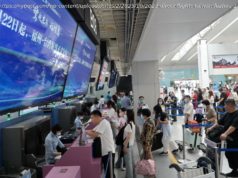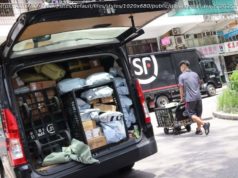 Less than a month after starting a business, a 24-year-old entrepreneur CNBC has agreed to call „Jack“ wired $70,000 to a factory in Shenzhen, China, praying that the money wasn’t going to disappear.
Less than a month after starting a business, a 24-year-old entrepreneur CNBC has agreed to call „Jack“ wired $70,000 to a factory in Shenzhen, China, praying that the money wasn’t going to disappear.
Weeks later, 15,000 plastic toy cubes with joysticks and clickers on their sides, designed to help people who fidgeted too often, arrived. A whole team exhaled, excited about the possibility of making $345,000 in just two months.
The Stress Cube staff knew they were taking risks as they tried to capitalize on the success of various products on crowdfunding sites. They also knew the rewards could be enormous.
For Jack, this all started with an inflatable chair.
After graduating from college in Canada, Jack found himself bored of working on behalf of yet another social app hoping to one day garner a billion-dollar valuation.
„I started realizing I wanted to run a company that actually sold something,“ he recalls.
Around the same time he noticed a start-up that appeared poised to do that faster than anyone. It was an Indiegogo campaign for KAISR, an inflatable lounge chair made of parachute material that had surpassed its goal by raising $18,500 in 12 hours last March (and eventually over $4 million).
As the Indiegogo gained in popularity, Jack’s research led him to realize that the idea was far from unique. In fact, the Lamzac inflatable lounge chair had already gone viral, five years after the idea was presented by its Dutch inventor on Holland’s TV show „Best Idea of Holland. “
The only thing that was new about this chair was the buzz from the crowdfunding campaign.
Jack wondered if he might be able to produce his own successful knockoff. A cursory search on Alibaba revealed manufacturers based in China that were offering product samples, and after minor sampling fees and a little back and forth with the winning factory, Jack had his product: The Cozy Bag.
With about $5,000 they pulled together, Jack and a partner launched their company. They bought 250 air lounges and secured a domain name, plus a handful of Square credit card readers. Within weeks, the team sold lounges directly at concerts and fairs. They spent full days building brand awareness and a following on Instagram and Facebook.
Sales grew, but margins slipped as they spent more and more on advertising, which was necessary to battle competitors like WindPouch, Dumbo Lounge and Chillbo Baggins.
Total revenue neared the $100,000 mark. Then Jack looked to leverage everything he learned from the first experiment on an even bigger viral hit.
In August, Google Trends had alerted Jack to what would become one of Kickstarter’s top 10 most funded projects in history: The Fidget Cube.
A small, handheld toy outfitted with six sides‘ worth of clickers and joysticks, The Fidget Cube promised to help anxious people occupy their hands. The campaign raised $15,000 on Kickstarter in less than a day and nearly $6.5 million in total.
But the project hit a snag when manufacturing issues caused a delay in deliveries. Many backers worried that they wouldn’t receive their cubes by Christmas.
As with Cozy Bag, Chinese manufacturers on Alibaba had been offering comparable products since shortly after the Kickstarter appeared. Thanks to their experience, Jack and his partners were able to pivot quickly and use WordPress and its sales plugin WooComerce to launch their Stress Cube site by the end of November.
They spent less than $5,000 on start-up costs, mostly on a bulk order of 1,000 plastic cubes at $3.65 apiece. The plan was to turn around and sell each for $19.99.
This time they used FollowLiker, automated software that helps grow followings and build brand awareness.
„It just wasn’t as apparent to me how powerful that can really be and how one Instagram ad can in three days generate $30,000 in sales,“ Jack says.
A week into operations, they sold over 100 Stress Cubes a day. At their peak, they sold about 800 a day. At that point, the 24-year-old and his partners had to bring on contractors to help with handling all the shipments and rent out a 400-square-foot office space.
When inventory from a second order dwindled, Jack and his two partners placed an order for 15,000 Stress Cubes and faced the terrifying prospect of wiring $70,000 to a factory in Shenzhen without insurance or any guarantee that the cubes would arrive.
„All I have is a Skype contact with some lady in China, and I don’t know what her name is — not that would matter if I knew her name, anyway,“ says Jack. „It was the scariest thing I’ve ever done. “
But the shipment arrived, and the fear subsided. Though Stress Cube’s founders still have cause to worry: A patent could shut down the operation that grossed them nearly $350,000 in just two months.
KAISR recently shut down operations and refunded much of the $4 million it raised after settling a lawsuit with FatBoy, the company which now owns the Lamzac patent. And FatBoy has since aggressively expanded its battle against competitors in the U. S., filing four cases against imitators, a company director said.
„One of the few downsides with crowdfunding is that everyone … can see how much hype and demand (including sales figures) surrounds a product,“ McLachlan says. „Our advice to other inventors is to just make the best product you can. “
Jack is primarily concerned about patents. „I’m checking every other day to see if there’s any new information,“ Jack says. But if he has to pivot again, that’s no problem. „The world is filled with products. I don’t need to sell Stress Cubes, I just want to sell products that people like,“ he says.
Start
United States
USA — China This 24-year-old made $345,000 in 2 months by beating Kickstarters to market






